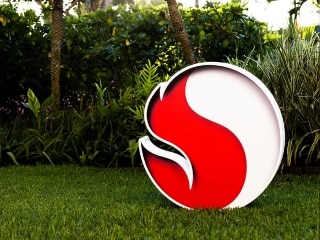- Home
- Wearables
- Wearables Features
- Augmented Reality Looks to Future Where Screens Vanish
Augmented Reality Looks to Future Where Screens Vanish

Kipman slipped on HoloLens augmented-reality (AR) headgear that his team is readying for market and became a wizard of sorts, calling forth magical landscapes, cold-hard data, and even summoning the hologram of a Nasa scientist for a chat.
Kipman spoke of HoloLens and other augmented-reality devices as a step in an evolution to a time when pecking at smartphone screens or computer keyboards are tales from generations past.
"I am talking about freeing ourselves from the two-dimensional confines of traditional computing," said Kipman, the creator behind Kinect motion-tracking accessories for Xbox video game consoles.
"We are like cave people in computer terms; we barely discovered charcoal and started drawing the first stick figures in our cave."
Walking on the moon
He touted the HoloLens headset he wore as the first fully-untethered holographic computer; not relying on a connection to a smartphone or computer.
A camera showed the TED audience what Kipman saw through HoloLens as he used gestures to turn the space around him into a cave, a fantasy land and even the surface of the moon.
He made a virtual television screen appear in the air, demonstrating how augmented-reality gear could eliminate the need for real TV sets.
"Computers give us superpowers," Kipman said as he transformed the world around him with holograms.
"In digital space, we have the power to displace space and time."
With another gesture, he launched a video phone call to his family in the US.
"I believe our children's children will grow up in a world devoid of two-dimensional technology," Kipman said.
"I can see holographical telepresence in our future."
To prove his point, Kipman had Jeff Norris of Nasa's Jet Propulsion Laboratory appear on stage in the form of a hologram seen through HoloLens.
HoloLens is already being used on the International Space Station and by Nasa scientists, according to Norris.
"For decadesm, we have explored from a seat, behind screens and keyboards," Norris said.
"Now, we are leaping over all of that... the antennae, the satellites and the vast space between worlds to step on the landscape as though we were really there."
Microsoft has made HoloLens kits available to developers for $3,000 a piece but has remained mum regarding when versions of the AR visors will be sold to consumers or at what price.
The plan is to have a rich array of applications, games and other AR experiences available before HoloLens hits the market, Kipman told AFP.
"You only get one chance to make a first impression," he said.
When Microsoft unveiled the HoloLens slightly more than a year ago, chief executive Satya Nadella billed it as a "mind-blowing" experience that will open a new type of computing.
A budding 'revolution'
Silicon Valley-based AR startup Meta let people at TED experience AR for themselves, with demonstrations that proved so popular the schedule was packed throughout the five-day gathering.
"I think Iron Man would be proud," Meta chief executive Meron Gribetz said while showing off the technology at TED this week.
Meron was referring to 'Iron Man' films in which the action hero creates wonders in his laboratory with the help of holographic computing that lets him manipulate virtual objects floating in the air.
"Being hunched over phones or computers is the wrong way," Gribetz said.
"In the next few years, humanity is going to go through a shift. We are going to start putting a layer of information over the world."
He predicted that within about five years, AR headgear would be slimmed down to mere strips of glass over people's eyes.
Meta did not disclose pricing or availability of its AR headsets, which plug into computers, but a countdown clock at the startup's website on Thursday indicated that "the revolution begins" in less than two weeks.
Catch the latest from the Consumer Electronics Show on Gadgets 360, at our CES 2026 hub.
Related Stories
- Samsung Galaxy Unpacked 2025
- ChatGPT
- Redmi Note 14 Pro+
- iPhone 16
- Apple Vision Pro
- Oneplus 12
- OnePlus Nord CE 3 Lite 5G
- iPhone 13
- Xiaomi 14 Pro
- Oppo Find N3
- Tecno Spark Go (2023)
- Realme V30
- Best Phones Under 25000
- Samsung Galaxy S24 Series
- Cryptocurrency
- iQoo 12
- Samsung Galaxy S24 Ultra
- Giottus
- Samsung Galaxy Z Flip 5
- Apple 'Scary Fast'
- Housefull 5
- GoPro Hero 12 Black Review
- Invincible Season 2
- JioGlass
- HD Ready TV
- Laptop Under 50000
- Smartwatch Under 10000
- Latest Mobile Phones
- Compare Phones
- OPPO A6 Pro 5G
- OPPO A6s
- OPPO Reno 15 Pro Max
- Honor Win RT
- Honor Win
- Xiaomi 17 Ultra Leica Edition
- Xiaomi 17 Ultra
- Huawei Nova 15
- Asus ProArt P16
- MacBook Pro 14-inch (M5, 2025)
- OPPO Pad Air 5
- Huawei MatePad 11.5 (2026)
- Xiaomi Watch 5
- Huawei Watch 10th Anniversary Edition
- Acerpure Nitro Z Series 100-inch QLED TV
- Samsung 43 Inch LED Ultra HD (4K) Smart TV (UA43UE81AFULXL)
- Asus ROG Ally
- Nintendo Switch Lite
- Haier 1.6 Ton 5 Star Inverter Split AC (HSU19G-MZAID5BN-INV)
- Haier 1.6 Ton 5 Star Inverter Split AC (HSU19G-MZAIM5BN-INV)
















